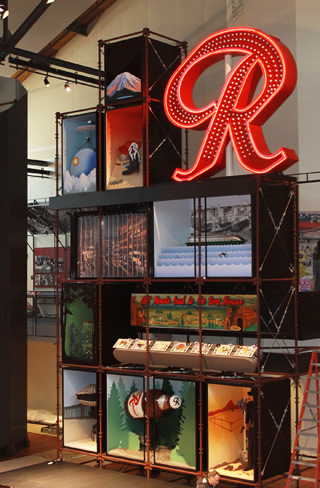|
Subscribe / Renew |
|
|
Contact Us |
|
| ► Subscribe to our Free Weekly Newsletter | |
| home | Welcome, sign in or click here to subscribe. | login |
Architecture & Engineering
| |
 Museum of History & Industry Museum of History & Industry |
January 7, 2013
A history museum that also shows our present and future
Pacific Studio

Salm
|
The answer: all of the above!
The answer to this question isn’t as important as getting people to ask the question. Most people are familiar with major historic events that are associated with Seattle: the Great Fire, the Klondike Gold Rush and the World’s Fair.
But what about the infamous Lusty Lady sign and the pink “toe” truck? Are they history? Of course! But where do you fit in, and are you part of this city’s history?
With MOHAI’s move to the newly reinvigorated South Lake Union neighborhood, they set out to create a museum that would celebrate their large collection of artifacts and images, and generate excitement for new exhibits. Pacific Studio was contacted to help with the design, fabrication and installation of the exhibits.
In our early meetings with the staff at MOHAI, they shared a quote from Seattle civic leader Jim Ellis that served as a creative compass for their vision: “We have the means and talent to create the city we want within our time.”
With this quote as our guide, we set forth on one of the most challenging and rewarding projects we’ve completed to date. It included the placement of more than 2,000 artifacts and images, hand-painted murals and interactive exhibits, all within a historic building that is as much of an artifact as its contents.
Our goal was to engage visitors and show them who we are as a community and how we got to where we are today by providing an environment that would allow them to learn about their city’s past, present and future all at once.
Landmark status
What made this project unique was the level of collaboration between MOHAI and our creative team. We worked closely with them from the beginning concepts of the museum through final installation. We collaborated with multiple partners, contractors, subcontractors and industry experts to develop these exhibits.
One of the greatest challenges museums face during renovations is securing funding to complete the project. We supported early fundraising efforts for MOHAI by creating conceptual renderings of the exhibits to match their vision, as well as a study model that showcased the new exhibit elements and large artifacts. They were able to use these materials to share their vision with their supporters and benefactors.
This project presented many unique challenges, not only due to the scope and large number of artifacts, but also the steps required to guarantee that MOHAI secured local and federal landmark preservation status for the building. We worked closely with MOHAI, the Seneca Group and LMN Architects to satisfy those requirements for the building, and now MOHAI is certified with the National Park Service as meeting federal standards for historic rehabilitation.
Towering challenges
Pacific Studio coordinated with the building team to ensure the building’s infrastructure (composed of electrical, HVAC, structural, lighting and life safety) worked together with and met the requirements for the exhibit. For example, structural reinforcement was required in order to safely display large artifacts such as figureheads from turn-of-the-century ships, the Slo-mo-shun IV hydroplane and the Boeing B-1 seaplane.
The 56-foot-high Faye G. Allen Grand Atrium space presented an ideal opportunity for dynamic exhibits, but it was not without some challenges.
Ann Farrington, MOHAI’s creative director, provided an early concept of four distinct towers to help define the expansive space. Each tower would ultimately present different aspects of Seattle history in the making.
The challenge for us was to design and build these two-story towers so there was minimal impact both structurally and aesthetically to the original architecture. In the end they were built to be detachable from the building and are considered temporary structures.
Early in the schematic phase of the project, Pacific Studio helped test construction concepts for the exhibit towers. We had to establish best practices and materials in order to meet the structural requirements together with the design aesthetic we set out to achieve.
Opting to use some materials typically thought of as temporary, we prototyped a small section of the tower in our shop, using scaffolding, stainless steel cabling and hardware, and a wall panel made of aluminum composite material. The concept was a success, and it allowed us to help MOHAI realize their vision for the space.
The grand atrium includes an interactive artifact grid structure that houses some of the larger and more playful iconic Seattle artifacts in the museum such as models of the Kalakala ferry, the “Hat and Boots” sculptures and an Ivar’s clam. We applied the same construction methods of that used in the exhibit towers to create a dynamic way to “play” with artifacts and replicas that will be familiar to a wide range of visitors. The end result is as dramatic and unique as the items they showcase.
Working with MOHAI and their other partners, we set out to creatively engage visitors with their city’s history, however recent it is. We are excited to share this project with Seattle and the people that will shape its future.
Al Salm is CEO of Pacific Studio.
Other Stories:
- Faced with a sloped floor, MOHAI crews rolled with it
- MOHAI's unique exhibits deliver surprising facts in surprising ways
- Making a new home for history on Lake Union



